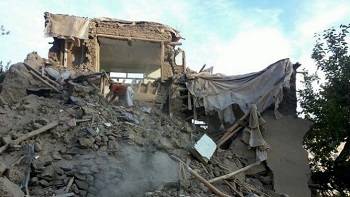260 killed as powerful quake rocks Pakistan, Afghanistan
27/10/2015| IslamWeb
Scores of people were killed in Pakistan and Afghanistan -- mostly in the former’s Khyber Pakhtunkhwa (KP) province -- after a 7.5-magnitude earthquake shook southern Asia on Monday afternoon (9:32 GMT).
According to the U.S. Geological Survey, the quake’s epicenter was 45 kilometers south-southwest of Jarm, Afghanistan, near the border with Pakistan.
At least 186 people were killed in Pakistan, where Monday’s tremors prompted city dwellers to flee their homes amid memories of a 2005 earthquake in Kashmir and KP province that left 100,000 people dead.
“Initially, I couldn’t figure out what was happening. But later I realized it was an earthquake,” said Sabir Hussein, who, along with hundreds of others, gathered at an open space in Peshawar. “Everything in front of me was shaking. I grabbed my daughter and pushed my wife out [of the house].”
Search-and-rescue operations are currently underway nationwide, with an unknown number of people still trapped under debris amid fears that the death toll could rise further.
The Pakistani government’s official earthquake monitoring division, meanwhile, has predicted “moderate” aftershocks over the next 24 hours.
The earthquake has affected mobile phone networks in several parts of the country, which will likely hinder search-and-rescue efforts.
Army Chief Gen. Raheel Sharif has instructed army personnel not to await further orders but to deploy on their own initiative to the most badly affected areas.
Communication and power systems have also been adversely affected after electricity stations and mobile phone towers collapsed in several remote parts of the country.
Ahmed Kamal, a spokesman for Pakistan’s National Disaster management Authority, told reporters that all of the country’s rescue agencies had been called up while reports of the damage were being assessed.
According to Kamal, the northwestern KP province was worst affected by the quake, where citizens have been directed to evacuate densely populated areas.
Medical officials say most of the casualties were in KP province, where scores of mud houses in mountainous areas were flattened.
The Grand Korakaram Highway, meanwhile, which links Pakistan to China, has reportedly been blocked in several areas by landslides caused by the earthquake.
Several other major roads and arteries countrywide -- especially in mountainous regions -- have also been blocked due to landslides, according to local authorities.
The government, for its part, has declared a countrywide state of emergency, while reserve medical staff has been called up to cope with growing numbers of dead and injured.
Pakistan straddles the Eurasian tectonic plate, making it historically prone to earthquakes.
In Afghanistan, meanwhile, at least 75 people -- including several schoolchildren -- were killed and over 100 people injured by Monday’s quake, according to local authorities.
In Takhar province, local health officials confirmed that 11 people had been killed and another 26 wounded.
Capital Kabul, too, was rocked by powerful tremors, leaving power and phone connections down temporarily.
Local observers in the Afghan capital say the quake lasted more than one minute, prompting numerous people to flee their homes
According to the Afghan Health Ministry, medical teams have been dispatched to the country’s most affected areas, while hospitals countrywide have been put in a state of high alert.
The local Tolo television channel reported that several houses had been completely destroyed in Kabul’s Dehmazang area, while a local school was partially damaged.
Another 18 homes sustained damaged in the capital’s Bagram district, while a number of others were damaged in the eastern Nangarhar province.
According to Mohammad Shafiq, a local journalist in the eastern Nangarhar province, six people, including two children, were killed, while dozens of injured people were taken to a provincial hospital.
According to reports from the northeastern Baghlan province, five schoolchildren were injured and several homes damaged due to landslides.
Ghulam Bahauddin Jailani, chief of Parwan province’s provincial council, said over 40 houses had been damaged in the province.
“We probably have casualties, too, but -- due to the loss of phone connections -- we can’t confirm them,” Jailani said.
The earthquake is also believed to have caused substantial damage in Badakhshan province, where much of the population lives in mud houses.
Afghan government officials, meanwhile, are currently holding an emergency meeting in Kabul to coordinate a national response to the crisis.
Monday’s quake was the strongest to hit Afghanistan in decades, according to local observers.
Later Monday, the White House offered condolences to the victims and said the U.S. was ready to provide necessary support.
Spokesman Josh Earnest said U.S. Agency for International Development -- the agency primarily responsible for administering civilian foreign aid -- was assisting victims with shelters and relief supply kits in warehouses throughout Afghanistan.
The quake was also felt in several parts of India, including the capital of New Delhi and regions of Indian-held Kashmir, Rajasthan, Gujarat, Punjab and Haryana.
People in the capital could be seen fleeing their homes, while metro services ground to a halt, although there were no immediate reports of serious damage or casualties.
Aftershocks, however, are expected, with officials advising citizens to seek shelter in safe areas.
PHOTO CAPTION
An Afghan man digs through the rubble of a damaged building after a powerful earthquake in Raman Kheel village in Panjshir valley
Worldbulletin

